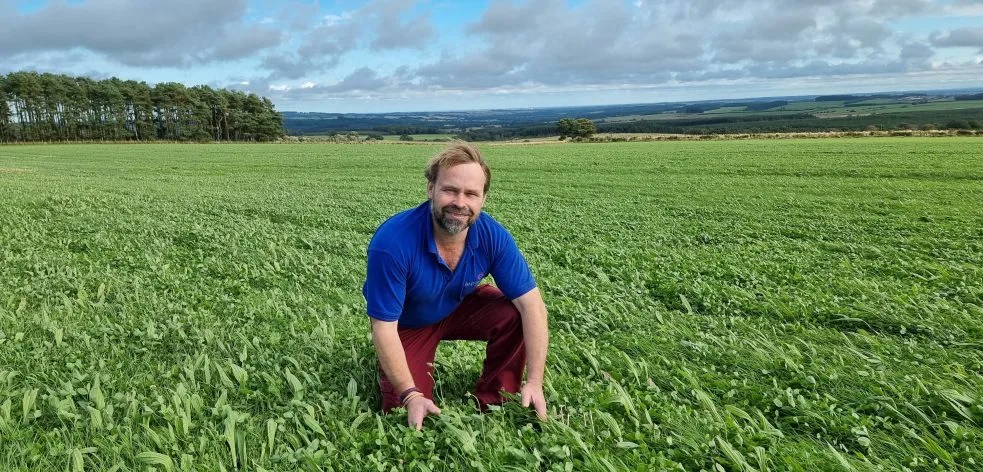Multi-species swards offer benefits for livestock performance, soil health and biodiversity. With the help of this guide, you can enhance the value of your grazing with our versatile and efficient forage solutions.
Contents
- What is a multi-species sward?
- How you could benefit from multi-species swards
- How to use multi-species
- Why multi-species can work
- Case study: Simon Bainbridge
- How to sow multi-species swards successfully
- White clover
- Red clover
- Perennial chicory
- Plantain
- Alternative multi-species grass seed, herbs & legumes
What is a multi-species sward?
Sometimes called herbal leys or diverse leys, multi-species swards are gaining popularity and taking their place in progressive, sustainable farming systems.
Used most often in sheep or beef enterprises, multi-species leys are also attracting interest from the dairy sector due to their beneficial effects on soil fertility and forage quality.
The mixture of plants drives dry matter production and areas of poor soil health benefit from the rooting structures' abilities to fix nitrogen. Their water uptake also increases performance in dry conditions while the dense sward resists poaching.
Germinal’s Aber HSG Multi-Species grass seed mixture comes in two options with legumes and herbs combined with Aber High Sugar Grasses (Aber HSG). This mixture provides a long-term ley ideal for multi-species rotational grazing and set-stocked grazing, while Aber HSG Multi-Species Cutting contains vetch and white clover seed for increased dry matter production.
What are the benefits of multi-species swards
Farmers are finding many reasons for using multi-species swards. Gaining more control over forage availability at either end of the season and maintaining dry matter in times of drought feature highly. But so, too, do improved soil fertility and structure as well as environmental benefits.
Livestock performance
- High digestibility driving dry matter intakes
- Better overall nutritional profile of forage, including high protein, energy, minerals and other trace elements
- Boost in spring and autumn production
- Greater weight gain in finished livestock
- Potential anthelmintic properties in herbs for parasite control
Soil health and the environment
- Nitrogen fixation from legumes (150-250 kg N/ha) reducing N fertiliser requirements
- Longer rooting species accessing deeper soil profiles
- Greater uptake of soil nutrients from multiple root systems
- Better soil structure and more active soil biology
- Dense sward increasing resistance to poaching
- Lower ammonia and methane excretion from the presence of high sugar grasses
- Greater carbon sequestration
- Improved water filtration
- Diverse wildlife habitats and attractive to pollinators
Reseeded and permanent pasture liveweight gain comparisons
| Crop type | Non-reseeded pasture | Aber HSG 3 + white clover | Aber HSG 3 + white & red clover, perennial chicory and plantain |
| Number of ewes | 138 | 138 | 138 |
| Number of lambs | 218 | 223 | 221 |
| Average weaning weight (kg) | N/A | 26.76 | 29.51 |
| Daily liveweight gain (g/day) | 200 | 325 | 364 |
Source: Germinal/AHDB, July 2017
How to use multi-species
These swards are inherently versatile and can be used as both grazing and cutting leys.
Multi-species grazing leys
Leys are ideal in multi-species rotational grazing systems where maximising productivity is a priority. Livestock graze selectively, favouring the more palatable species.
To avoid preferred species being over-grazed and lost from the sward completely, limit grazing periods so favoured species can re-establish.
Multi-species can be used in set-stocking, but there is less control over grazing and more likelihood of some species going to head and losing quality. The utilisation rate is lower than in a rotational grazing strategy.
Regenerative (or mob) grazing has the potential to restore soil health very effectively. Multi-species leys can be an integral part of this although utilisation rates are low.
As red clover seed produces forage containing phytoestrogens, it is recommended to avoid putting ewes on a multi-species grazing ley six weeks pre- and post-tupping.
Cutting leys
Multi-species grass seed mixtures intended for cutting are most effective when they include vetch and clover. Vetch and FIXatioN clover increase protein and dry matter potential in the first year, while the white and red clovers included provide these in subsequent years.
It is also best to use a mixture without species such as perennial chicory, as they easily go to head and produce a woody stem.
Take care to protect the delicate leafy species in these leys, such as red clover, by using a rubber roller conditioner and handling carefully during wilting and rowing-up.
Why multi-species can work
Mixtures containing a variety of species work due to the competitive and complementary characteristics of different plant types. The contrasting leaf and root architectures use light, moisture and nutrients more effectively above and below the ground.
A multi-species pasture mix contains at least one type of grass, legume and herb. The Aber HSG Multi-Species grass seed mixtures combine three high sugar grasses with Timothy, plantain, chicory, vetch and both red and white clovers – the specific composition tailored to grazing or cutting.
The mixture components each bring a unique feature:
| Mixture components | Features |
| Mixture of three top-performing Aber HSG perennial ryegrasses | Dense sward and high-quality performance |
| Timothy | Resilience |
| Plantain & chicory | Deep roots and rich in minerals, drought resistance |
| Vetch & FIXatioN clover | Protein and increased dry matter production in first year |
| White clover | Protein & N fixation |
| Red clover | Persistence, protein & N fixation |
Case study: Simon Bainbridge
Farm details
- Bainbridge Farms, Donkin Rigg, Northumberland
- 1,650 acres, including 300 acres multi-species cutting leys
- 180 suckler beef
- 1,500 breeding ewes
- 24,000 laying hens
Using multi-species to improve resilience
Simon Bainbridge farms 1,650 acres in Northumberland rearing suckler beef, breeding ewes and laying hens. No concentrate or grain is fed to the ruminants, relying solely on grass and forage to finish stock.
Simon first planted multi-species leys to improve the farm’s resilience in dry periods after forage yields dropped by 50% in the 2018 drought.
About 300 acres of multi-species cutting leys are now established, mainly comprising clovers, perennial ryegrass and Timothy, plus Tonic plantain and vetch.
The rotation starts with a break crop of brassicas, followed by an arable silage crop of barley and vetch undersown with multi-species grass seed.
“The barley/vetch combination is working well, but we try to harvest it as soon as possible so it doesn’t smother the new ley,” explains Simon.
The farm only uses manure and lime for fertiliser and Simon is pleased with how the new forage crops are performing: “Lamb growth rates are really good. I think the different rooting depths of the multi-species help break up the pans bringing different minerals to the surface.
“Cattle are doing well too – we have sent finished cattle on at 20 months, which were only fed milk, grass and forage crops.”
How to sow multi-species swards successfully
Soil type
Multi-species leys are best suited to lighter, drier soils, as herbs can struggle in heavier or waterlogged soils.
Timing
The optimum sowing period is similar to most grassland leys but ideally delayed a week or two compared to straight ryegrass.
Legumes and herbs do better when soil temperatures are a few degrees higher. Avoid sowing much beyond the end of August so root systems have enough time to develop fully before the onset of winter. Final sowing dates may need to be earlier the further north it is sown.
Seedbed
A clean seedbed is essential. If a high weed burden is expected and time allows, create a stale seedbed. Ring roll before sowing to make sure the seedbed is fine, level and firm, allowing good seed-to-soil contact.
Soil nutrition
Most species establish more easily in a fertile seedbed. Aim for a soil pH of 6-6.5 and soil indices of 2 for phosphate and potash.
Some less dominant species, including burnet, yarrow, birdsfoot trefoil and fescues, can thrive in less fertile soils where conditions offer warmth, moisture and good seed-to-soil contact.
Seed rate and mixture composition
Seed rate depends on the type of mixture and method of establishment but is broadly similar to sowing a grass and clover sward. It ranges from 10 kg/acre when under-sowing to 15 kg/acre when sowing conventionally. In some cases, seed rates need to be higher to accommodate optimum levels of all species.
Multi-species mixtures need to include 60-80% high-quality ryegrasses to give the sward a good base and help it knit together.
Sowing methods
Multi-species grass seed mixtures are sown at a shallow depth of 5-10 mm to give the small-seeded species the best chance of timely germination.
Broadcasting is the most common and effective method of sowing when the seedbed is clean, fine and firm. Direct drilling can be used but allows the more aggressive ryegrass and clovers to dominate and outcompete the slower-establishing species.
Under-sowing can also be used in spring with an early-maturing, lodging-resistant cereal companion crop, drilled at a reduced seed rate (not exceeding 120 kg/ha).
Annual legumes, such as crimson clover or vetch, can be under-sown where an early first cut for silage takes out any annual broad-leaf weeds.
In rotational systems, preceding crops should be cereals, roots or brassicas, which reduce soil nitrogen levels encouraging the establishment of the legumes in a multi-species grass seed mixture.
Sowing Aber HSG Multi-Species Grazing and Cutting
| Features | |
| Rate | Grazing: 34 kg/ha (13.75 kg/acre) Cutting: 45 kg/ha (18.25 kg/acre) |
| Time | March/April or August |
| Depth | 5-10 mm or broadcast |
| Conditions | Moist and warm soil conditions (minimum 8-10°C) Drill into a fine tilth Roll before and after drilling for good soil-to-seed contact |
Pests and disease control
There are limited agrochemical options for the control of pests and diseases so good management is necessary. Break cropping as part of a rotation is useful. Brassica fodder crops are a good option for this both as an effective pest and disease break but also an additional quality forage.
Common pests include:
- Slugs: particularly troublesome in drilled crops
- Stem eelworm: distorts buds and young leaves
- Sitona weevil: more common in areas close to arable crops
- Leatherjackets: check for damage after ploughing old pastures
Early management
Give the new ley a light graze when it passes the ‘pull test’. The pull test is done by trying to tear off a handful of grass. If the whole plant comes out, the sward needs more time to establish – if just the leaf tears, it’s ready to graze.
Early grazing helps promote growth and encourages roots to anchor but avoid hoof damage and over-grazing. An early cut can help control annual broadleaf weeds.
White clover
White clover increases dry matter intake by livestock and helps maintain productivity at times when grass growth may drop.
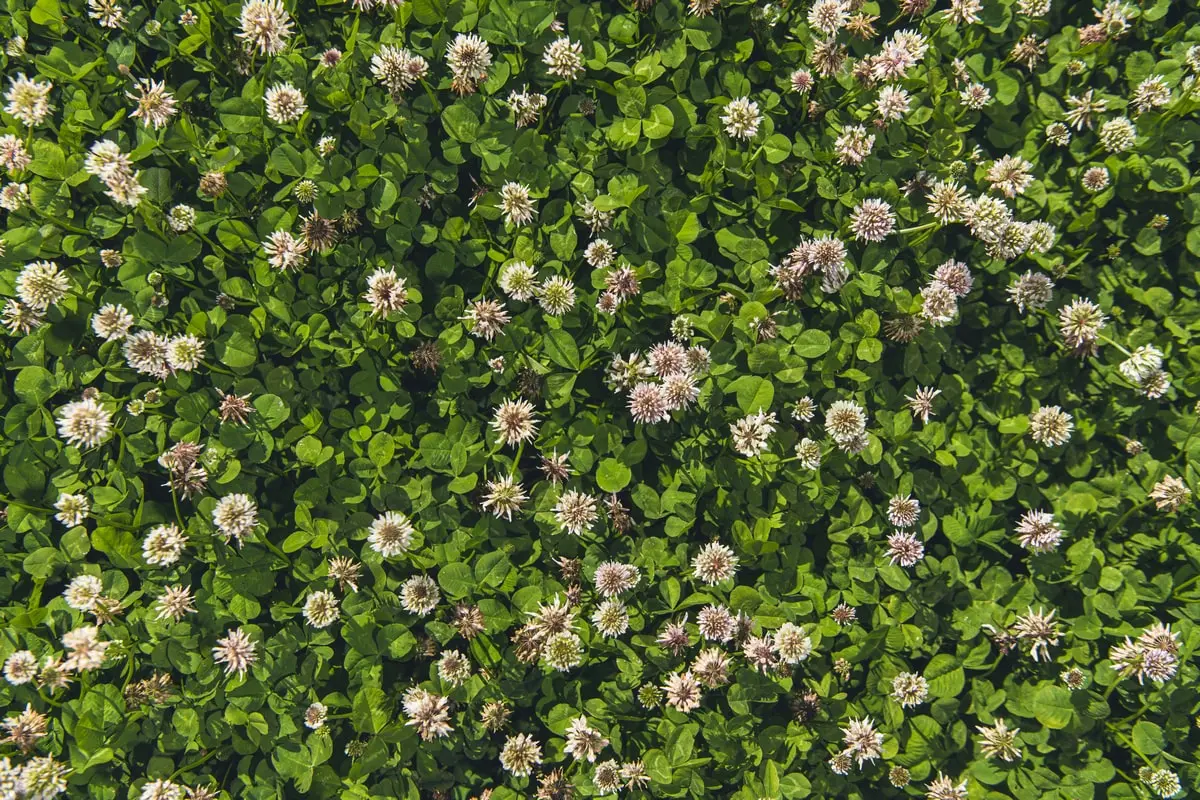
Benefits of sowing white clover seed
- Nitrogen fixation equivalent to 150-250 kg N/ha
- Increased dry matter intake
- High protein and mineral content
- Enhanced soil structure
- Tolerates dry conditions
- Creeping stem (stolon) structure increases grazing tolerance and winter hardiness
Grazing management
- Keep grass at 4-6 cm over winter to protect clover stems/stolons from frost damage
- Check clover content of the sward in spring. Increase with intense grazing or apply nitrogen to reduce the sward clover content
- During the season, use intensive grazing, particularly by sheep, as a break on clover content or less frequent cutting to increase clover
White clover seed blends
Bred at IBERS, Aberystwyth University, Germinal’s white clover blends are leading the way in producing higher yields and lasting longer. Best grown as a companion to perennial ryegrass, Germinal’s white clover blends are tailored to the sward’s primary use.
Aber HSG Multi-Species Grazing contains AberPasture, ideally suited to cattle set stocking and rotational sheep grazing. Aber HSG Multi-Species Cutting, meanwhile, includes AberDairy for high production cutting and grazing.
Red clover
Red clover is a high-quality, cost-effective source of protein reducing reliance on bought-in feed.
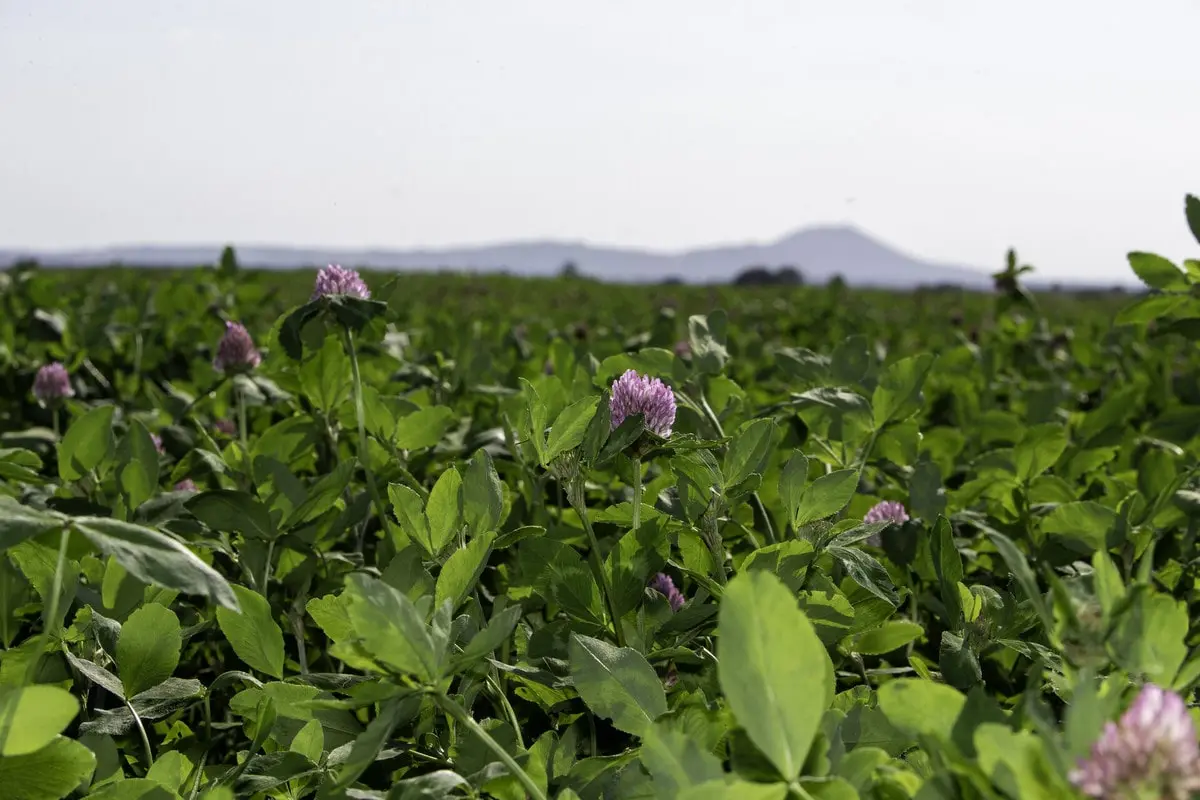
Benefits of sowing red clover seed
- Nitrogen fixation equivalent to 150-250 kg N/ha
- Yield potential of 10-15 t DM/ha/year
- High protein content
- Beneficial break crop
- Improves soil structure and nutrient status
- Superior lamb growth rates
- Combined effectively with Puna II perennial chicory and Tonic plantain for outstanding lamb finishing
Red clover management
- Graze swards lightly in the autumn of the sowing year
- Graze autumn regrowth lightly to finish lambs and cattle
- Cut when 30-50% flowers are red
- Harvest carefully with a plain roller or rubber roller conditioner to prevent leaf damage
- Cut at a height above 7 cm and avoid tedding
- Ensile at 25-30% DM to minimise wilting losses
- Avoid grazing in wet/moist conditions to limit bloat and reduce poaching
Perennial chicory
Perennial chicory is a broad-leaved herb ideally suited to a mixed sward of grass and clover for medium to long-term rotational grazing. A perennial variety, Puna II chicory gives greater persistency (two to five years) compared to the short-lived common chicory.
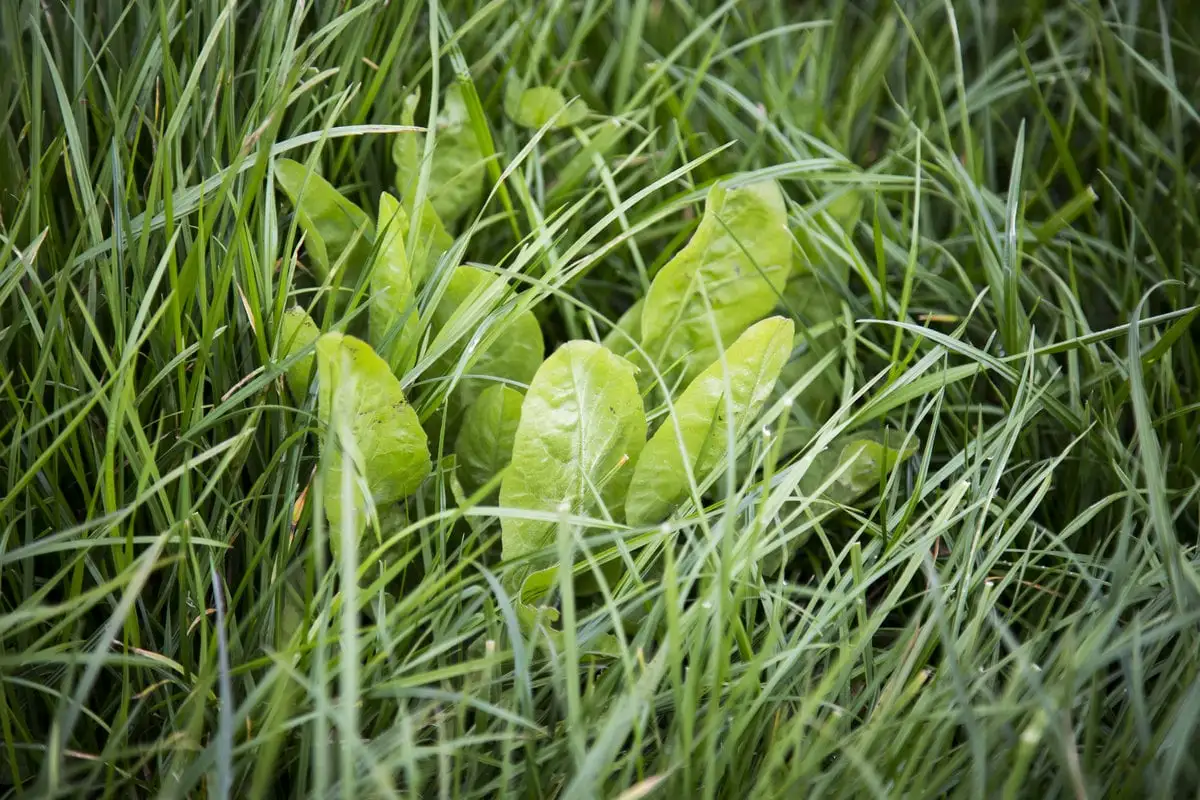
Benefits of Puna II perennial chicory
- High palatability to drive growth and productivity
- Outstanding animal performance (for example, lamb growth rates of 300-400 g/day)
- Yield potential of 10-15 t DM/ha/year
- High protein and mineral content, including zinc, potassium and copper
- Good drought and disease tolerance
- Rapid regrowth after grazing
Management of Puna II perennial chicory
- Graze rotationally, ideally in short, light spells in the first year
- Aim for grazing strategy to prevent flower heads from developing
- Avoid hard grazing in wet conditions to prevent crown damage
- If plant growth is too vigorous, control by grazing cattle
- Growth rates fall at soil temperatures below 10°C
Plantain
Plantain is a perennial forage herb used in mixed-species swards to boost growth and liveweight gain. It is well suited to intensive or rotational multi-species grazing systems for dairy and beef cattle, sheep and finishing lambs. Tonic is the leading UK variety combining well with Aber High Sugar Grasses and clovers.
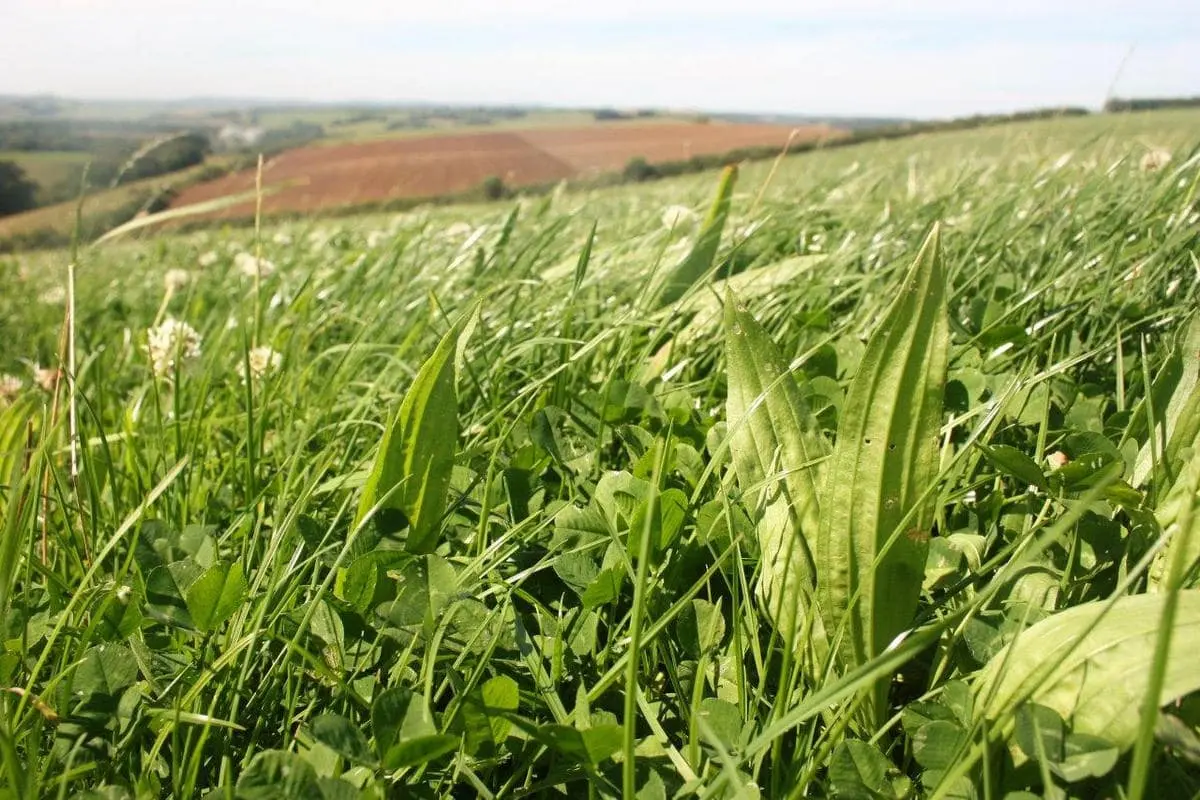
Tonic plantain benefits
- High protein and mineral content, particularly selenium and copper
- Stimulates milk production
- High digestibility to drive intake and growth
- Increased daily liveweight gain
- High dry matter production from early spring to late autumn
Tonic plantain management
- Graze rotationally, ideally in short, light spells in first year
- Aim for grazing strategy to prevent flower heads developing
- Avoid hard grazing in wet conditions to prevent crown damage
- If plant growth becomes too vigorous, control by grazing cattle
- Growth rates fall at soil temperatures below 10°C
Alternative multi-species grass seed, herbs & legumes
The following species are all suitable for use in multi-species leys providing either grazed or ensiled forage. They fall into the three major plant types found in multi-species leys: grasses, legumes and herbs.
| Species | Variety | Features |
| Grasses | Timothy | All soil types Generally disease-free Suitable for silage, hay or grazing Persistent |
| Cocksfoot | Drought tolerant Persistent Requires tight grazing | |
| Meadow fescue | All soil types Drought tolerant Persistent but low yielding | |
| Legumes | Alsike clover | Fixes nitrogen Lasts 2-3 years |
| Balansa clover | Rapid establishment; high biomass Annual; short-term forage Fixes nitrogen; conditions and improves soil fertility | |
| Birdsfoot trefoil | Lasts 3-4 years Provides protein for ruminants Not suitable for use with lucerne or red clover Non-bloating; some anthelmintic properties Drought tolerant | |
| Berseem clover | Rapid, competitive growth Can tolerate heavier, wet soils Suitable for haylage | |
| Crimson clover | Grows well in shade Suitable as an under-sown companion crop | |
| Hairy vetch | Vigorous spring growth High-quality, high-protein forage Suitable cover crop | |
Black medick (Yellow trefoil) | Short-lived annual/biennial Suitable for under-sowing & soil improvement | |
| Herbs | Burnet | Perennial Increases diversity Rich in trace elements Suitable for multi-species grazing over a long season |
| Sheeps parsley | Increases diversity Rich in trace elements Suitable with grassland crops to increase grazing quality | |
| Yarrow | Increases diversity Rich in trace elements Suitable with grassland crops to increase grazing quality Non-bloating; some anthelmintic properties |
Ask the grass and forage experts
For advice on transforming older pastures with multi-species, contact one of the Germinal forage experts.

